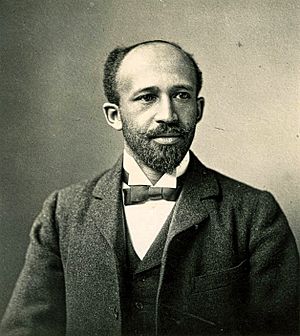The Philadelphia Negro facts for kids
 |
|
| Country | United States |
|---|---|
| Language | English |
| Publisher | University of Pennsylvania Press |
|
Publication date
|
1899 |
| Media type | Print (hardback) |
| Pages | 520 |
| LC Class | PF158.9.N3 D8 1899 |
The Philadelphia Negro is an important book by W. E. B. Du Bois. It is a study about the lives of African Americans in Philadelphia. The University of Pennsylvania asked Du Bois to write it, and it was published in 1899. The main goal was to understand the social problems faced by the African American community at that time.
This book was the first big study of a Black community in the United States. It also showed how sociology (the study of human society) could use facts and numbers to understand people and their lives. Du Bois collected information for this study between August 1896 and December 1897. He carefully mapped every Black home, church, and business in Philadelphia's Seventh Ward. He also recorded details about jobs and families. Du Bois's research helped him understand the idea of "race" better. He realized that problems faced by Black people were often like "old world questions" of not knowing enough, being poor, crime, and not liking strangers. He used examples and surveys to support these ideas in his book.
Contents
Understanding Community Challenges
In the 1890s, many Black people in Philadelphia faced challenges. These were similar to problems seen in other areas of the U.S. where people had low incomes. Issues like crime and poverty were common. These problems made life difficult for the community.
How the Study Was Done
To collect information, Du Bois and his wife moved into the 7th Ward of Philadelphia. He gave out surveys in poorer areas, especially on Saint Mary Street, from 1896 to 1897. With help from his assistant, Isabel Eaton, Du Bois used old records, statistics, and questionnaires. These surveys asked about jobs, health, education, and religious, social, and family life.
Du Bois and Eaton went door-to-door in the ward. They collected more than 5,000 personal interviews. This survey data included how many Black people lived in the city. It also had information about where they were born, their jobs, age, and gender.
The study focused on the central Seventh Ward. This area stretched from Spruce Street to South Street and from Seventh Street to the Schuylkill River. Even though it was a neighborhood study, the area was very diverse. Wealthy white people lived on its western side. The center had many successful Black families. The eastern side was home to many poor people of both races. This eastern part was also known as the city's Black ghetto.
What the Study Found
Du Bois's research in Philadelphia showed a community that was diverse and making progress. However, it also clearly showed that poverty, crime, and illiteracy (not being able to read or write) were real problems. Du Bois explained this by saying that Black people within the community had their own different social classes. So, they should not be judged only by the "submerged tenth." This referred to the 10% who were struggling the most.
He also said that the "Negro problem" was not just one issue. Instead, it was "a mix of social problems." These problems were less about a "social sickness" among Black people. They were more about white people causing racial discrimination and not giving equal chances. For example, Du Bois found that African Americans had to pay "very high rents for the worst places to live." He noted that "race-prejudice makes this difficulty worse, and many bad things come from it."
Du Bois highlighted that the "Negro problem" had social and historical causes. For instance, Black people were often kept out of the best factory jobs in the city. Also, many Black families lived in single-family homes. The lasting effects of slavery and unfair race relations also played a big role.
Ideas for Solutions
At the end of his study, Du Bois wrote a section called "The Meaning of All of This." In this part, he explained that the biggest challenge for Black people in America was how most Americans saw them. He believed that if people changed their view of Black people from being less capable to being equally capable, many problems in the Black community would get better.
Du Bois wrote that for change to happen in Philadelphia's Black communities, both Black and White communities needed to work together. He listed responsibilities for both groups in this section.
How It Is Remembered Today
In spring 2008, Philadelphia's Mural Arts Program created a mural. It was in partnership with The Ward project. This mural, called Mapping Courage, honors the history of The Philadelphia Negro. It is on the side of Engine Company 11's building at S 6th Street and South Street. This fire company was one of the first 22 fire companies in Philadelphia's paid fire department, started in 1871. Until the Philadelphia Fire Department officially ended segregation in 1952, Engine 11 was the main firehouse for African American firefighters in Philadelphia. The company's original building still stands and is now part of the Waters Memorial African Methodist Church.
See also
 In Spanish: The Philadelphia Negro para niños
In Spanish: The Philadelphia Negro para niños


